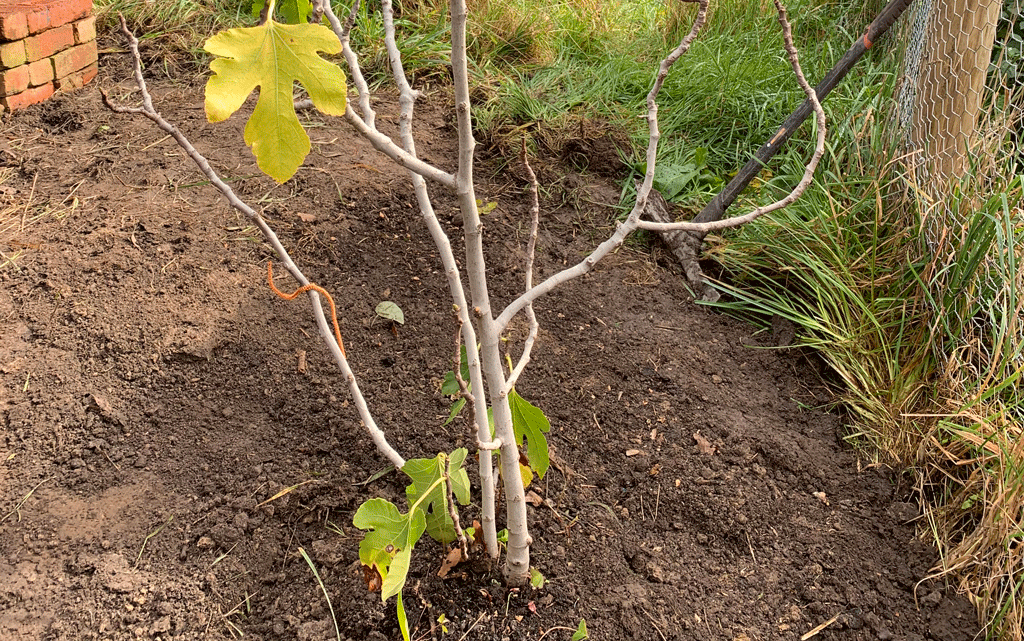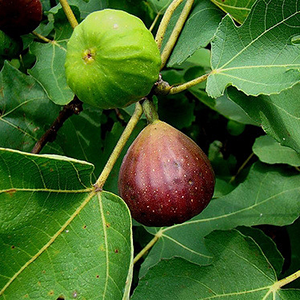
The Wonder of Growing Figs
I was astounded in my childhood when somebody asked ‘What plants have their seeds on the outside of their fruit?’ I had never thought of it before, though I’d eaten strawberries countless times. The wonder of that fact keeps coming back to me. However, across the many decades of my life, nobody has ever asked me the question, ‘What plant has their flowers on the inside of their fruit?’
Now, as an old man, I find out for the first time that figs are the only creatures in the plant kingdom to have flowers inside of their fruit. The pulp inside the fig-fruit is hundreds of tiny unisexual flowers. In more technical terms, the fruit (the synconia) of self-fertile types of fig are hollow structures that contain only female flowers. Amazingly, there are no seeds in this kind of fruit.
This is a question that needs to be asked of all children. We need to find a way of returning to the mystery of the fig tree. Figs have been saved from industrial agriculture because their fruit is difficult to store and transport, but we have also lost contact with the long historical and natural meaning.
We planted a fig this weekend at Platypus Bend, a gift from friends, Andrew and Nina. It is the first tree that we have planted here, the first of what we intend to many plantings, mostly indigenous, but also exotic, fruit-bearing, and beautiful.
Figs are the Tree of Life
Figs are the tree of life. They are the subject of origin stories in many cultures. Figs provide the means of symbolic and mythical living when all else is tenuous. When the Kutia Kondh people of Odisha, India, were becoming human, their Goddess Nirantali formed the first human tongue from the quivering leaf of the Ficus religiosa. When the earth and the sky became separated, all that connected the Maasai to life were the aerial roots of a fig tree. Their cows descended on the fig roots (Shanahan, 2018).
And it was not the temperate-zoned apple, but as Michelangelo painted in the Sistine Chapel, the Mediterranean fig that was presented to Eve when she walked in the Garden of Eden. Fig leaves were used to cover the shame of human sexual discovery. We all know the consequences of the Council of Trent’s Fig-Leaf campaign of 1563 – floating fig leaves strangely drawn to the genitalia of humans.
Figs are inexplicable. These remarkable trees survived the mass-extinction event 66 million years ago that killed three-quarters of life on Planet Earth—the dinosaurs and ancient forests. Fig trees flourished in the aftermath and spread around the globe forming hundreds of new species that become basic to human life. Recent research shows that fig cultivation predated cereal domestication. Carbonized fig fruits have been dated to 11,400 years ago, stored in Gilgal I, an early Neolithic village in the Lower Jordan Valley, and harvested from parthenocarpic (seedless) trees grown from intentionally planted branches (Kislev, et al. 2006).
My reading also took me to the practical question of how to tender a fig tree. What are the technicalities of growing figs?
Growing Figs
Fig trees need full sun for at least eight hours a day, protected from strong winds and frost. Nevertheless, they also need 100 hours of chilly weather to set fruit. Planted behind our corrugated iron shed, looking north, it should do well.

The fig planted here (25 April 2021) is a Ficus carica species, ‘Brown Turkey’. It is noted for its cold-and-heat resilience. This ‘common fig’ does not need pollination. It produces large conical brown-purple fruit with pink-amber flesh, cropping from February to May (at least in the south-eastern Australia).
Pruning
Plant in late autumn to earlier spring. A newly planted fig, particularly a bare-rooted plant, should be pruned by half to stimulate root growth. While figs grow three-to-ten meters high, they can be pruned heavily over their life-times back to a metre-and-a-half high. Pruning is done in late winter to make gathering fruit easier. Cut back to leaf nodes. Tip-pruning last year’s growth back to a metre-and-a half keeps the tree at a height that is manageable for picking, but also encourages fruiting. This is because most of the fruit grow on the new season’s wood. I will gently prune this potted version.
pH
Figs like slightly acidic soil, but will flourish from 6–7.5 pH.
Soil
Growing figs is possible in all soil types but they thrive in organically rich, well-drained soil with well-rotted compost. We will bring in more organic material; the soil here is grey fertile loam from the creek valley.
Mulching
Figs are shallow rooted so they benefit from mulching. It is best not to cultivate around the base of the tree. I will mulch in spring.
Fertilizing
For growing figs a high potassium fertilizer is optimal. A high-nitrogen, fast-release fertilizer will promote strong leaf growth at the expense of fruit growth.
Harvesting
Pick when the figs when they are ripe—slightly soft to touch and beginning to split—because they will not ripen off the tree. If they split too readily it is because they tree has received too much water.
Oh, I am looking forward to that first picking, and the years beyond.